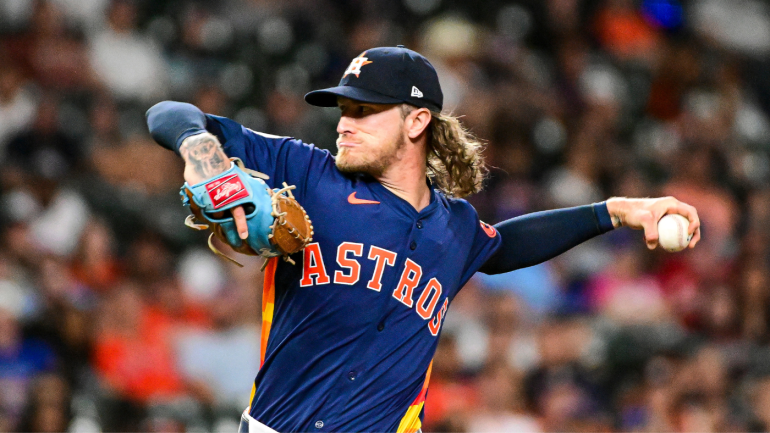
Astros closer Josh Hader has had a curious start to the season, his first since signing a five-year pact worth $95 million with Houston in January. He's already made five appearances over the team's first 11 games, including on Sunday against the Texas Rangers, when he closed out a win to record his first save of the year.
Yet Hader has experienced his share of early season turbulence. He's suffered two losses to date and, for just the fourth time in his career, he's surrendered at least a run in three consecutive outings. That includes his converted save. To recap those games:
March 31 vs. Yankees: Hader entered a tied game in the top of the ninth. He yielded a pair of hits, including a single to former Padres teammate Juan Soto that plated the go-ahead run. Hader was charged with a loss.
April 2 vs. Blue Jays: Hader entered with a one-run lead. He erased a leadoff single with a double-play ball. He then walked a batter before surrendering a go-ahead home-run to Davis Schneider. Again, he was charged with the loss.
April 7 vs. Rangers: Hader entered with a three-run lead. He walked a batter who later scored on a Justin Foscue base hit. Hader recovered to coerce a game-ending double-play ball off the bat of Ezequiel Duran to secure the save.
Even great pitchers -- and Hader is, without question, one of the best relievers of his generation -- can have bad weeks. Most of the time, that's all it is. Sometimes, though, diving into a small sample can reveal interesting differences in how an established player is conducting business. That indeed proved to be the case with Hader.
Rather than fret too much about Hader's results to date, we figured it would be more worthwhile to explore two notable tweaks he's made to his game.
1. More sliders, fewer sinkers
Whenever you're sizing up a pitcher, one of the most obvious places to look is their pitch usage breakdown.
Sure enough, Hader has thus far deviated from what has been a tried-and-true approach for him to spam the opposition with his sinker. He's never thrown fewer than 65% sinkers in a season, and he's dipped below 60% for a month only twice in his career: once in May 2021, the other in June 2023. So far this season, Hader is throwing 58.8% sinkers. If it holds -- and April is far from over -- it would represent the lowest sinker usage month in his career.
Hader has replaced those missing sinkers by upping his slider usage rate. He's chucked it less than 30% of the time in each of the last three seasons. Yet in 2024, he's throwing his slider at a career-high 40.2% rate. That would represent a new single-month high.
Josh Hader, K'ing the Side. ⛽️
— Rob Friedman (@PitchingNinja) March 28, 2024
Different uniform.
Same Josh Hader. pic.twitter.com/oZ7hCeXLbP
Hader hasn't publicly discussed why he's throwing more sliders. Maybe he simply feels more comfortable with the pitch, or maybe it had to do with the opponents he faced. Making an assumption that these shifts are wholesale changes is part of the danger that comes with reading too much into small samples.
Say Hader is intentionally throwing more sliders as a broader shift. Why would he mess with an approach that isn't broken? Our hunch is to lean into the modern trend of prioritizing the individual's best pitch. Hader's slider is his top swing-and-miss offering and the pitch that he's least likely to give up a home run on.
To wit, prior to the home run Schneider hit on April 2, Hader had not allowed a home run on a slider since July 13, 2022.
2. Working down, not up
In addition to altering his pitch mix, Hader has taken to pitching down in the zone more frequently than in the past. According to TruMedia's data, Hader has located more than 57% of his pitches in the lower half of the zone. Last season, for reference, he located 39.5% of his pitches in that same area of the zone.
It may seem obvious that a pitcher shifting away from their fastball and toward their slider would also change their average location in a manner consistent with Hader's tweak -- generally, pitchers are most prone to elevate their fastballs while keeping their sliders down -- but that effect isn't the only thing going on here.
Indeed, take a look at Hader's sinker location over the last five years:
| Season | Upper half% | Lower half% |
|---|---|---|
2021 | 61.8% | 38.2% |
2022 | 53.7% | 46.3% |
2022 | 51.2% | 48.8% |
2023 | 60.5% | 39.5% |
2024 | 42.3% | 57.7% |
Again, you may ask yourself why Hader would make this shift -- if it is indeed an intentional one. Our guess is that it would be in response to pitching in a less-friendly pitching environment than he experienced as a member of the San Diego Padres. Pitching down in the zone, then, could be Hader's way of fending off additional home runs. Whether or not that works out in practice is to be determined. So far, it's left him one double play away from matching last year's total in 56 fewer games.
Will Hader stick by these changes, and will they allow him to continue to post his usual superb results? We'll have to keep an eye out. At minimum, he serves as a good reminder that there are potentially interesting things to be found in small samples.


















